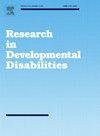儿童运动评估系列中哪些项目对识别可能患有发育协调障碍的儿童最为敏感?这是一项大规模研究的结果。
IF 2.9
2区 医学
Q1 EDUCATION, SPECIAL
引用次数: 0
摘要
导论:尽管广泛使用儿童运动评估系列,第二版(MABC-2),但很少有人知道单个项目检测可能的发育协调障碍(p-DCD)的敏感性或特异性。本研究考察了哪些特异性的MABC-2项目对识别p-DCD儿童最敏感,哪些项目可以预测p-DCD。方法:基于大型数据集,包括3-16岁欧洲和非洲儿童(n = 4916,典型发育(TD, 49.6 %男孩);n = 822 p-DCD(53.1 %男生),计算Hedges' g以建立p-DCD/TD之间的标准化平均差(SMD)。当smd绝对值等于或高于1.4时,smd被认为是实质性的。采用logistic回归分析,建立MABC-2单项评分预测各年龄段p-DCD/TD的敏感性和特异性。结果:AB1: p-DCD儿童在穿线珠子(SMD: -1.61)和跳垫子(SMD: 1.61)上表现明显较差。结合所有项目和原产国,敏感性为61.7 %,特异性为98.6 %。AB2:从脚跟到脚趾向前行走(SMD: 1.65)的p-DCD明显较差。结合所有项目和原产国,敏感性为79.0% %,特异性为97.6% %。AB3:用首选(SMD: 1.8)或非首选(SMD: 1.61)的手接球,以及从脚跟到脚趾向后行走(SMD: 1.78)的p-DCD明显较差。所有项目的综合结果敏感性为94.4 %,特异性为99.6 %。结论:并不是所有的MABC-2项目对p-DCD和TD的性能都具有相同的敏感性。尽管具有良好的特异性,但在AB1-2这个儿童学习受文化影响的运动技能的年龄,敏感性仅为中等。本文章由计算机程序翻译,如有差异,请以英文原文为准。
Which items of the movement assessment battery for children are most sensitive for identifying children with probable developmental coordination disorder? Results from a large-scale study
Introduction
Despite the widespread use of the Movement Assessment Battery for Children, 2nd edition (MABC-2), little is known about the sensitivity or specificity of the individual items to detect probable Developmental Coordination Disorder (p-DCD). This study examined which specific MABC-2 items were most sensitive to identify children with p-DCD and which items would predict p-DCD.
Methods
Based on a large dataset including European and African children aged 3–16 years (n = 4916, typically developing (TD, 49.6 % boys); n = 822 p-DCD (53.1 % boys), Hedges’ g was calculated to establish the standardized mean difference (SMD) between p-DCD/TD. SMDs were considered substantial when absolute values at or above 1.4. Sensitivity and specificity of the raw MABC-2 item scores predicting p-DCD/TD per age band (AB) were established with logistic regression analysis.
Results
AB1: Children with p-DCD performed substantially poorer on threading beads (SMD: −1.61) and jumping on mats (SMD: 1.61). By combining all items and the country of origin, the sensitivity was 61.7 % and specificity 98.6 %. AB2: Walking heel-to-toe forwards (SMD: 1.65) was substantially poorer in p-DCD. By combining all items and the country of origin, the sensitivity was 79.0 % and specificity 97.6 %. AB3: Catching a ball with the preferred (SMD: 1.8) or non-preferred (SMD: 1.61) hand, and for walking heel-to-toe backwards (SMD: 1.78) were substantially poorer in p-DCD. All items combined resulted in a sensitivity of 94.4 % and specificity of 99.6 %.
Conclusion
Not all MABC-2 items are equally sensitive to distinguish between performances of p-DCD and TD. Despite the good specificity, the sensitivity was only moderate in AB1–2, the age at which children learn culturally influenced motor skills.
求助全文
通过发布文献求助,成功后即可免费获取论文全文。
去求助
来源期刊

Research in Developmental Disabilities
Multiple-
CiteScore
5.50
自引率
6.50%
发文量
178
期刊介绍:
Research In Developmental Disabilities is aimed at publishing original research of an interdisciplinary nature that has a direct bearing on the remediation of problems associated with developmental disabilities. Manuscripts will be solicited throughout the world. Articles will be primarily empirical studies, although an occasional position paper or review will be accepted. The aim of the journal will be to publish articles on all aspects of research with the developmentally disabled, with any methodologically sound approach being acceptable.
 求助内容:
求助内容: 应助结果提醒方式:
应助结果提醒方式:


